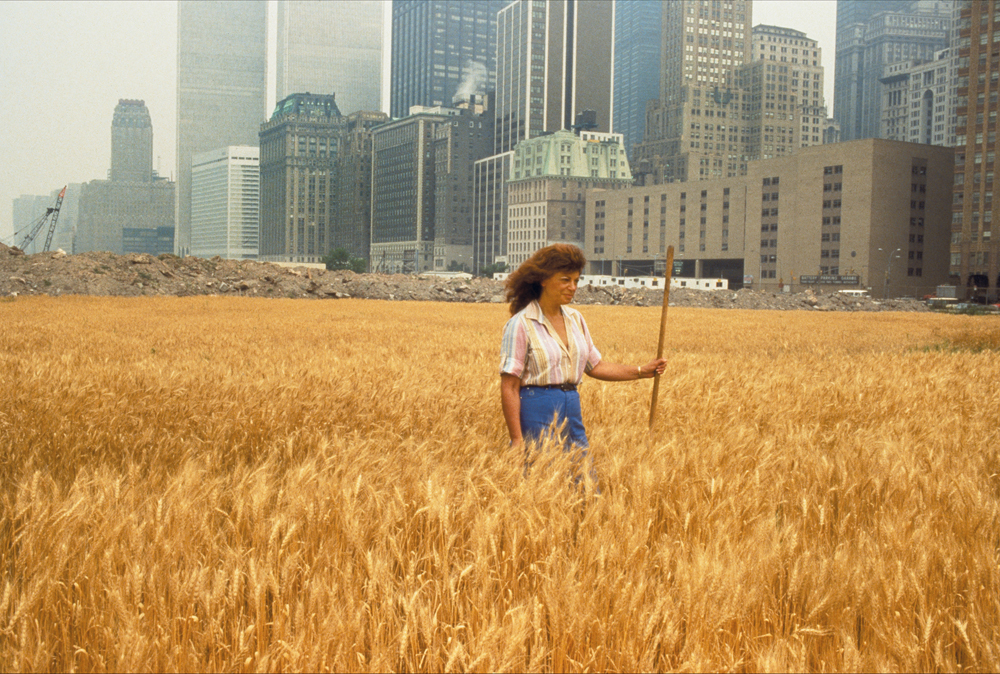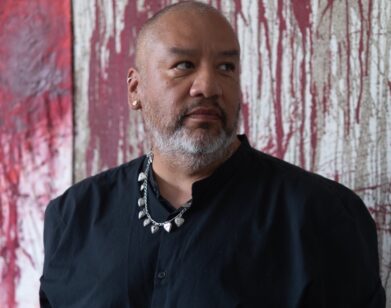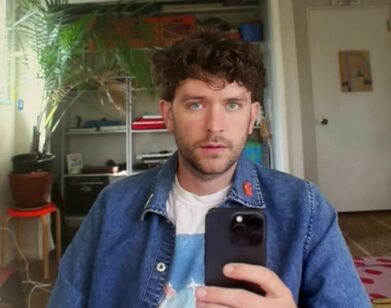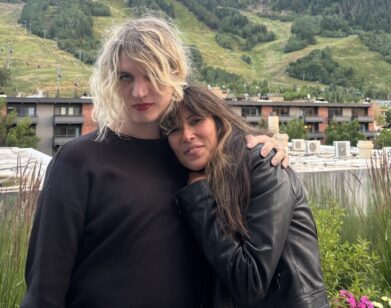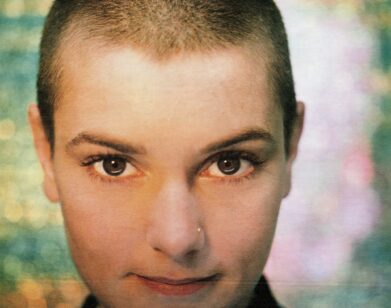Agnes DENES
Since the late 1960s, Hungarian-born artist Agnes Denes has created large-scale, public environmental installations including, perhaps most famously, 1982’s Wheatfield—A Confrontation, in which she planted, tended, and harvested a two-acre field of wheat on a landfill in lower Manhattan not far from the World Trade Center. In a widely reprinted image of the work, Denes, in blue jeans and a striped shirt, stands alone in a field of golden wheat framed by the buildings of the financial district. The provoking work contrasted urban and rural, finance and agriculture, manual labor and artistic value, and also revolutionized the possibilities of public art. Still prolific at age 83, Denes is planning two major projects for 2015. This month, she’ll present The Living Pyramid, her first large-scale public work in New York since Wheatfield; a 30-foot-tall living sculpture constructed from tons of topsoil planted with grasses and wildflowers, the installation will be presented at Socrates Sculpture Park in Long Island City, Queens. Also this summer, a new version of the iconic wheat field will be grown and harvested on five hectares of land in the center of Milan at the invitation of Fondazione Riccardo Catella, Fondazione NicolaTrussardi, and Confagricultura.
A pioneer of earth art, Denes was born just before earthworks artists like Walter De Maria, Robert Smithson, and Richard Serra. While her work also utilizes the landscape as a site, unlike those artists, Denes’s mathematical forests, rice fields, wheat fields, and pyramids developed alongside the growing environmental movement of the 1970s and an interest in minimizing man’s ecological impact on the natural world. Today Denes still lives and works in a loft in the center of SoHo. Tables are covered with intricate plans for projects both realized and as-yet unconstructed; the walls are lined with philosophy books. She invited me there this past February to talk about her new pyramid in Long Island City, mathematics, inventing a new kind of airplane, and being a woman artist in New York in the male-dominated art world of the 1960s and ’70s.
MAIKA POLLACK: How did the project at Socrates come about?
AGNES DENES: How do all projects come about? They say, “There is Agnes Denes—let’s do something with her.” To me the most important thing about a work is the machinations of how it comes about, working it out, working with these guys [Socrates directors Elissa Goldstone and Katie Denny Horowitz], learning about the difficulties of the project, and rising to the occasion. Because I’m alone so much—research, libraries, writing—collaboration is wonderful.
POLLACK: You created your first ecological site work in the late 1960s. How did you get involved in making public art?
DENES: Public art existed all along, but ecological art just naturally grew out of my thinking and writings in that area for years. I didn’t get involved in it; I started what then became a movement.
POLLACK: Critic Klaus Ottmann links the work that you’re doing to Joseph Beuys and Allan Kaprow as part of a critique that harnesses creative practices to challenge social norms and the status quo. So it seems like there’s this moment in your practice when you stop making paintings, let’s say, and you start making work that has a public impact …
DENES: I became involved in this, more or less, at the tail end of abstract expressionism. And I’m mostly self-taught. I didn’t learn much in school. But I was always interested in these issues. And I had to see if it’s not painting that I wanted. So I went through about six or seven painting methods just to see what I didn’t want to do. And then I got off the wall, and went into the environment.
POLLACK: Were you aware of Allan Kaprow at that time?
DENES: No, I was not in touch with many of the artists who were functioning at that time. And then when I became interested in them, they would not allow me to be in their group, because it was a close-knit boys group. So I was on my own—totally. And there’s something good about that. Because not only did you dig deeper into yourself, but adversity—in other words, not getting acknowledgements from outside—brings out the best in you. To react to it and to become better.
POLLACK: Would you say there’s a relationship for you between painting and earth art or land art in terms of coming off the wall?
DENES: I was finished with painting. I was totally finished with it. What I did for my last act as a painter, if you call me a painter, was to photograph the weave of the canvas, and enlarge it and enlarge it until it became like a landscape. It wasn’t a conscious thing. It just became a landscape. And then I went into the landscape. Most wonderful things are unconscious. The most important works were done early on, like the private ritual for the Rice/Tree/Burial [an “event” in which Denes planted rice, chained trees, and buried a time capsule of her haiku poetry, in Sullivan County, New York] was ’68.
POLLACK: Tell me more about Rice/Tree/Burial.
DENES: The work was created for philosophical purposes to begin with. To evaluate, for instance, a relationship to the earth. The way we put our seed in it, for it to grow. The way we put our dead in it. The way we put time capsules in it to communicate with the future. All of humanity is this tiny, little surface around the globe. It’s what? Fifty feet high, where humanity exists? That’s it, all of humanity. We go beyond it a little bit, sometimes. Go up to a hundred feet, or a thousand feet, with a building. But mostly life is 50 feet above the surface. So I found that fascinating, and that’s why Rice/Tree/Burial was born. I did that as a private ritual. I planted the rice field, which was planting seed in the ground; chained trees to indicate interference with life, life and death, communication, and thesis/antithesis/synthesis was the basic concept for that. And that’s how it started. So it wasn’t for expansion or using anything large out there, but it had to be created in the environment.
POLLACK: When you say it was a private ritual, what role does photography play in these performances or events? Because I’ve seen photographs of this and other works of yours—the photographs of Wheatfield are iconic.
DENES: I did most of the photography myself, by the way, for Wheatfield.
POLLACK: Well, you’re in one of them.
DENES: I’m in one of them; that was a Life photographer who came. He said, “Hold the staff in your hand.” I said, “That’s ridiculous.” He said, “Just hold it.”
POLLACK: And that’s the one that gets printed everywhere.
DENES: Yeah, that’s the only one.
POLLACK: So you were in charge of most of your own photography for the other works?
DENES: There’s nobody else to do it, so I had to do it.
POLLACK: I was just at a panel at MoMA where the discussion was about photography’s relationship to performance.
DENES: I never thought of myself as a performance artist until they said, “Well, you’re performing out there.” I am? You know, you look into the project and you don’t see yourself the way other people see you. So I never considered myself a performance artist. But that’s unimportant, that’s neither here nor there. We were talking about the earth art or land art, which started for different reasons than mine. My reasons were philosophical and about changing the ecology. It was, like, 45 years ago. Nobody thought about that. Nobody even believed that it was important. And even today you have to really convince people. Even today there are people saying there is no global warming. I mean, people are always fighting reality until it’s pushed down their throats. It’s amazing. For some land artists, to extend their studio space was more ego; it was not for ecological purposes. I’m not accusing only men of having egos because everybody has an ego, but their art was not for the purpose of ecological reasons; it was to expand their art, to have more space. And Smithson, whose work I like very much, he died flying over a field that he was surveying for a drawing in space. My work is about helping humanity. Looking back on my work, I now see that each one of them is trying to help a major problem for humanity and trying to give it a benign solution. Every one of my works, when I’m looking back, becomes some kind of solution, or something to concentrate on. Something to pay attention to and maybe change direction.
POLLACK: Do you ever walk by that area [formerly Battery Park Landfill, now Battery Park City in lower Manhattan] where Wheatfield was planted?
DENES: I had to be there for another reason. And it was a pang, a real tug. There are condominiums and office space, a new city, Battery Park City. It just pulled at my heartstrings. Because I almost died doing Wheatfield, I worked so hard. I put in 16-hour days, and I had volunteers because I had no money. And I felt I had to feed the volunteers, to reciprocate for their help. So when I finished with the field, with directing it, running it, photographing it, I had to go home and make sandwiches for the volunteers the next morning. So it was like seven days a week, total commitment, and worrying about the field. But nobody harmed the field. People don’t hurt what they love.
POLLACK: How did you know how to raise wheat?
DENES: I study what I work with. I studied all these different fields of science that I needed for my work. I studied how to mine a landfill and what to plant in it. It’s fascinating because you learn a new field each time.
POLLACK: Have your concerns about the environment changed since the ’60s and ’70s? You wrote about being against industrial expansion.
DENES: No, it’s just that some of the things I talked about 40 years ago have become reality. When we attended global conferences and talked about all the earth warming and the problems about climate change, nobody listened to us. It was mostly scientists; I was just one artist there. And nobody gave a damn about it. People always understand everything in retrospect. You know the saying, “You live life forwards and understand it backwards”?
POLLACK: Is there a piece you wanted to see realized and haven’t had the opportunity yet?
DENES: There are many. A different kind of Stonehenge, more mathematical forests around the world, the future city, and the restless pyramids. Brain-Maze, Starfilled/Starfield, World on Fire.
POLLACK: I was just reading about Brain-Maze; it’s an outdoor labyrinth mapped out on the ground in the shape of the two hemispheres.
DENES: I proposed that for Socrates. Next time. In my next life.
POLLACK: Your work often looks to the future. Like your Future Cities [in the 1980s and ’90s, Denes designed imaginary cities that cope with ecological change—these plans take the form of drawings and prints]. Are there any projects that you’ve planned that could be realized in a hundred years’ time? There was one I was looking at, Bird Project, where you proposed tagging migratory birds.
DENES: Oh, that’s such a sore point. I wanted to do that work so badly. I grew up, in part, in Sweden, and there was this island, Öland Island. The birds would come there before they migrated south to nest. On this little island, they were forced into each other’s flying space. Bird flocks don’t like to fly with each other because they get disoriented, and they started committing suicide. It’s such a big thing in Sweden, the suicide, a lot of attention and study is given to it. So as a kid I became interested in why the birds commit suicide, why they would stop flapping and fall to earth. Then, having been displaced, and coming to New York and being a foreigner, so to speak, I connected that to the birds flying into each other’s airspace—they become foreigners. They get disoriented. I connected the birds and the people. Not that they commit suicide, but they become different people. Later on, I got a small grant from the American-Scandinavian Foundation to do the project and I went back to Sweden and visited the bird stations. I designed a plane that was between a plane and a helicopter that would fly with the birds—very small propeller with a film camera attached to it, to pinpoint the moment the bird decides to commit suicide, the moment they stop flapping and become disoriented. But I never got to build it. So that was my first great disappointment.
POLLACK: When I looked at the proposal to track bird flight patterns, I thought that if the technology had been a little more advanced back then, you really could have done it.
DENES: But somebody has already done it. There was somebody who got some money not so long ago and they were flying with the birds. Not with my concepts, but they were flying alongside the birds. So now I’d be a second person doing it. It’s like if I built the crystal pyramid now in Paris, I’d be after I.M. Pei, and people would think I took his ideas. Once your ideas don’t get out, you go to the next idea and the next and the next. So the projects that I don’t get to do are for the future. When I’m bye-bye. [laughs]
POLLACK: Dear Homo Futurus, as you addressed one of your letters.
DENES: When I’m gone, you’ll be sitting in a cafe and say, “Do you remember Agnes?” [laughs]
POLLACK: You talk about making the invisible visible in your Manifesto from 1970. How do you give mathematics, or these other invisible structures that order the world, a visible, almost physical presence in your work?
DENES: When you attempt to make time visible, logic visible, mathematics visible, how do you do it? I created this new art form of making it visible. That was the whole basis to it. So I had drawings that were the first time that mathematics was put into visual form. I had a drawing of half a million numbers. It took me one and a half years to do. So that’s how I made the invisible visible. And then I have a drawing of the thinking process. Theoretical crystallography. Visualizing invisible structures. There is a drawing where I wanted to see what kind of a form mathematics would give me if I didn’t think of any form. I just allowed the numbers to dictate the form. I got this strange little monster. It’s amazing that I could do that, looking back. Now my fingers are not moving anymore. I was diagnosed with this disease that attacked my fingers. Aside from that, I would do something like that again to see where mathematics would lead me without me interfering at all, just allowing mathematics to rule the game. For instance, when I planned mathematical forests [an ongoing series of works in which thousands of trees are planted in a pattern based on mathematical formulas, such as intersecting spirals or the golden section; one was realized in Ylöjärvi, Finland (1992-96), and another in Melbourne, Australia (1998)], they’re different from other forests. The tree is made by nature, mathematics by people. And combining the two is creating this beautiful alliance between humanity and nature. That’s why my forests are mathematical expansion systems, all of them. In Finland, in Australia. And now I’m planning a forest for New York—50,000 trees.
POLLACK: Where will you plant the forest?
DENES: This is the first time I’m talking about it, officially. It’s going to be at Edgemere. [Part of the Rockaways Peninsula, in Queens, the Edgemere Landfill was once the oldest continually operating garbage dump in the United States and is now a remediated Superfund site where no permanent structures can be erected until 2021; there are plans to turn it into a park.] I have not been commissioned yet. But I hope they will help me do it, because we do need a forest for New York. I don’t know if it’s going to be a mathematical forest; I just know that I want to do it. And it’s very important to clean the air. We need fresh, clean water and fresh air. And I’m also planting another wheat field, in Milan, Italy.
POLLACK: Oh, that’s fabulous.
DENES: It’s not going to be a re-creation of Wheatfield, but it’s going to be 12 or so acres of wheat in the center of Milan.
POLLACK: That will be stunning. And an interesting place to do it, too.
DENES: In the center of the city is so important.
POLLACK: Art today exists primarily within a system of galleries and art fairs, but rarely seems to leave the art world.
DENES: I want to leave it. Period.
POLLACK: Who taught you how to be an artist?
DENES: I don’t think you can learn much except for the basics. One of my teachers said to me, “Here is a good example of the student surpassing the master.” He was a very sweet Italian man. He painted white on white. And I drove him crazy, because I went into these crazy art forms, one after the other. Just doing this and that. He said, “Don’t ever imitate anybody. Don’t you know that you are an original?” I said, “But I have to, to know that I don’t want it.” So I went through all these forms, reject, reject, reject. Until I got to enlarging the canvas.
POLLACK: In the ’70s and ’80s, when you were showing at the New Museum, Franklin Furnace, and Ronald Feldman Fine Arts downtown, who was coming to the openings? What was your SoHo crowd like?
DENES: They put me into different exhibitions because they didn’t know what to do with me. I had dots connecting mathematics so they put me in a show with the pointillists. It’s crazy. Society likes to file you away, put you in this or that category. And I never fit any category. Maybe that’s why I was left out of a lot of things, or why my work was not really understood, because there was no precedent for it. There’s no precedent for women philosophers and there’s no precedence for most of the things I did. And I did it before the boys, and at the same time not knowing any of them. I did heavy philosophical thinking at the same time. And then they called me a conceptualist. You see? So everything happened to me in a roundabout way. And it wasn’t their fault; it was probably my fault that I didn’t befriend these people or push myself there. I always was alone. And I’m alone today. It’s fine. I have lots of friends, but not in terms of working together. If I like a person, I like them. I may like the art and not like the person. But one thing that’s paramount in my life is that I am alone. I’m a loner. And yet I have many friends and I don’t feel lonely. And I even like my own company. But when I’m alone, it’s to read or write. I’m in my thoughts. Mostly I’m learning.
POLLACK: If the male land artists were not your community, who was your community? Everyone turns to some group.
DENES: The garbage collector, the people around the corner, the library people. Scientists. Philosophers. I worked with AT&T, Bell Laboratories. I was a fellow at Carnegie Mellon.
POLLACK: Is that when you did the computer piece? [For Hamlet Fragmented-Wittgenstein’s “Pain,” 1971, Wittgenstein’s Philosophical Investigations was programmed into a computer and subjected to alterations, among which the word pain was changed to pleasure; Hamlet’s lines from Hamlet were also altered by computer to remove articles and prepositions. These experiments were then printed.]
DENES: No, I did research there. I went to Carnegie Mellon, I went to MIT; that was interesting. I was teaching a course at MIT, teaching eggheads. And then Bell Laboratories. I was a fellow at all these places.
POLLACK: But you were there as the artist.
DENES: Yes. And it was interesting that they loved talking to me, because I was on a level with their intellect. Well, one tried to chase me around the table. But mostly they respected me. After a while they stopped thinking of me as a woman, which was the greatest compliment that I could get. One person once said to me, “You’re not going to be acknowledged as anybody important until you stop being so beautiful.” I was so insulted, but he was actually right. I was good looking, and it stood in the way. Then I overcame that. And the scientists loved to talk to me because I talked their language. When I was at MIT, I talked with artificial intelligence—that was wonderful. I worked with Otto Piene … Where was that? I have a very bad memory for names.
POLLACK: Otto Piene, the Zero group artist who did the fire paintings. Do you want to talk about the work you’re showing at Socrates? Because it’s different from the pyramids you’ve presented before.
DENES: The pyramids all relate to each other, and pyramids are so important because they’re social structures. I hate to put tags on things, because tags change, and they change with the requirements made on them. And we’re changing modes and needs. Words are changing. I find that old expressions are outdated, so when I write something, I try to find a new expression that hasn’t been born yet. It’s difficult. We use up words as we use up images. We use up everything, and that’s good, because it makes us grow. But the pyramids are very important in that they’re representatives of concepts. That’s why the understructure is so important—that it should not be the most visible thing in it, but the least visible. Because concepts have to be standing on a very sturdy understructure, the underpinnings.
POLLACK: What’s the understructure?
DENES: The understructure of thinking, of everything. Thinking has an understructure and underpinnings.
POLLACK: So how are you dealing with the superstructure of the pyramid?
DENES: I want the superstructure to be beautiful. That’s like when you deal with difficult philosophical concepts, you have to make your images visible to get the viewer. And once you get through admiring the beauty, you’ve got them. They start thinking. Otherwise they would walk away from thinking. People have too many problems during the day; they don’t want to think. So I want to make this pyramid as beautiful as possible.
POLLACK: So there will be flowers on top?
DENES: The flowering and the grasses and the fact that it’s alive. But it should be alive with mysterious inner forces.
POLLACK: What are you putting in this pyramid? Is there something secret inside? [Denes laughs] Yes, there is! And you can’t tell me what it is.
DENES: I wish I could. I want it to be as small and as powerful as possible. Anything important has to be almost invisible. And underrated. So the understructure should be underrated, but strong enough to hold the earth.
POLLACK: And then people will come and they can enter the park during the daytime?
DENES: Oh, they can’t climb it. Unfortunately, they can’t. You don’t want to step on grass and flowers! And the planting is going to be all outside of the pyramid. So what I’m trying to design are these little structures that hold the plantings the way you have in windows of buildings, where they have a little tray outside that holds the earth and the flowers. So that’s what I want all around the pyramid, interlocking planter boxes. And let’s hope we can do it as unobtrusively as possible. The philosophy meets the wildflower. You see, philosophy gets its ugly head into everything, but I don’t think we live philosophy anymore. It’s done.
POLLACK: Do you feel like you could have picked a different field and gone just as far into it—like artificial intelligence?
DENES: Well, if I could relive my life, what I would do is work with scientists. But not one scientist, because they’re locked into their little specializations. I’d go from scientist to scientist to scientist, like a bee goes from flower to flower. They say it’s a very male thing. [laughs] I have this insatiable curiosity about everything. I wish I didn’t have daily problems to deal with, so that I could just concentrate on learning more, every single day.
MAIKA POLLACK IS A NEW YORK-BASED WRITER. SHE IS A VISITING PROFESSOR AT SARAH LAWRENCE COLLEGE AND PART OF THE FACULTY AT BARD COLLEGE. SHE IS THE CO-FOUNDER OF SOUTHFIRST, A CONTEMPORARY ART SPACE IN BROOKLYN.

